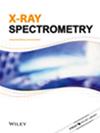WD-XRF technique for speciation of iron and quantification of its oxidation states in geological samples using L-series of iron X-ray spectrum
IF 1.5
4区 物理与天体物理
Q3 SPECTROSCOPY
引用次数: 0
Abstract
Wavelength dispersive X-ray fluorescence (WD-XRF) spectrometry is a fast and widely used technique for elemental analysis of geological samples from Na to U. However, it has seldom been applied for quantitative determination of oxidation states of elements in complex matrices. In this study, we present a method to determine the oxidation states of iron in geological samples by WD-XRF. We used the FeLα1,2 fluorescence line as a tool for iron speciation and Fe(II)/Fetotal ratio determination. We found that the normalized intensity (peak height) of FeLα1,2 fluorescence line was linearly correlated with the spin multiplicity (2S + 1) of ferrous and ferric content in the samples. To account for the matrix effects of chemical environment (matrix and chemical bonding) on FeLα1,2 fluorescence line, we introduced a chemical index factor (μ) that enabled accurate determination of Fe(II)/Fetotal ratio in different types of geological samples. The method was validated using international certified reference materials and their mixtures and obtained promising results, with only 6 out of 55 determinations showing relative error more than 5% of the certified values.利用 L 系列铁 X 射线光谱的 WD-XRF 技术对地质样本中的铁进行标本分析和氧化态定量
波长色散 X 射线荧光光谱法(WD-XRF)是一种快速而广泛应用的元素分析技术,可用于分析从 Na 到 U 的地质样品,但很少用于定量测定复杂基质中元素的氧化态。在本研究中,我们提出了一种利用 WD-XRF 测定地质样品中铁氧化态的方法。我们将 FeLα1,2 荧光线作为铁的种类和铁(II)/总比率测定的工具。我们发现,FeLα1,2 荧光线的归一化强度(峰高)与样品中亚铁和铁含量的自旋倍数(2S + 1)呈线性相关。为了考虑化学环境(基质和化学键)对 FeLα1,2 荧光线的基质效应,我们引入了化学指数因子 (μ),从而能够准确测定不同类型地质样品中的铁(II)/总铁比率。我们使用国际认证的参考物质及其混合物对该方法进行了验证,结果令人满意,在 55 次测定中,只有 6 次的相对误差超过认证值的 5%。
本文章由计算机程序翻译,如有差异,请以英文原文为准。
求助全文
约1分钟内获得全文
求助全文
来源期刊

X-Ray Spectrometry
物理-光谱学
CiteScore
3.10
自引率
8.30%
发文量
38
审稿时长
6-12 weeks
期刊介绍:
X-Ray Spectrometry is devoted to the rapid publication of papers dealing with the theory and application of x-ray spectrometry using electron, x-ray photon, proton, γ and γ-x sources.
Covering advances in techniques, methods and equipment, this established journal provides the ideal platform for the discussion of more sophisticated X-ray analytical methods.
Both wavelength and energy dispersion systems are covered together with a range of data handling methods, from the most simple to very sophisticated software programs. Papers dealing with the application of x-ray spectrometric methods for structural analysis are also featured as well as applications papers covering a wide range of areas such as environmental analysis and monitoring, art and archaelogical studies, mineralogy, forensics, geology, surface science and materials analysis, biomedical and pharmaceutical applications.
 求助内容:
求助内容: 应助结果提醒方式:
应助结果提醒方式:


